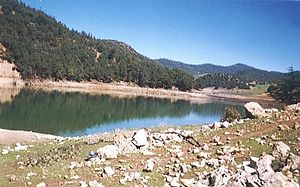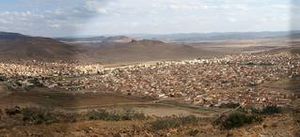Khénifra (province)

The Moroccan province of Khénifra ( Central Atlas Tamazight ⵜⴰⵙⴳⴰ ⵏ ⵅⵏⵉⴼⵔⴰ ), which is around 4,000 km² in size and has a population of around 400,000 , has been part of the Béni Mellal-Khénifra region since 2015 .
geography

location
The province of Khénifra lies in the transition zone from the mountains of the Middle Atlas to the Moroccan Meseta and borders in the southeast on the province Midelt , in the southwest on the province Béni Mellal , in the west on the province Khouribga , in the northwest on the province Khémisset , in the north the province of El Hajeb and to the east to the province of Ifrane .
landscape
In the hilly landscape of the province, which is about 750 to 850 m high on average, there are smaller mountain ranges, the peaks of which reach heights of around 1000 to a maximum of 1600 m; it is crossed by several smaller rivers ( wadis ), all of which arise in the Middle Atlas, but partly seep away in the plateau after they have been used for drinking water and for agricultural irrigation purposes. The Oum er-Rbia is the longest of them; it rises about 40 km northeast of Khénifra, then flows in a south-westerly direction, absorbs the waters of other rivers and flows into the Atlantic at Azemmour .
climate
The province's summer climate is hot and dry: daytime temperatures can reach 40 ° C; at night the thermometer falls to around 15 to 25 ° C, depending on the cloudiness. The early morning hours are coolest. The winter daytime temperatures are around 20 ° C and drop to 5 to 10 ° C at night; Night frosts are rare, but occur on around 10 to 20 days each year. In the mountain regions of the Middle Atlas, which rise up to 2000 m, it is significantly cooler.
population
In the largely agricultural province of Khénifra, around 80% of Berbers from various tribal groups and a smaller percentage of people of Arab origin live; the colloquial language is tamazight. While the Berbers are mainly active in agriculture, the leading positions in civil service and administration as well as in the economy and in the liberal professions are held by Arabs. In the province there are officially only the two cities Khénifra (approx. 80,000 inhabitants) and Mrirt (approx. 40,000 inhabitants); the rest are considered rural communes ( communes rurales ), even if, for example, the villages of the rural commune of Aguelmous together also have around 40,000 inhabitants.
economy
Thanks to the possibility of irrigation, the agricultural yields are comparatively high. The cities provide the residents of the surrounding area with the necessary technical, educational and medical services.
history
Historical records from the region around Khénifra are not known. In 1914, the Berber tribes living in the area offered great resistance to the French, who allegedly lost 600 men in a battle near the city. Also in the period of the Moroccan independence movement, i. H. in the early 1950s, the city played an important role. The province of Khénifra was established in 1973; However, it has been reduced in size several times - most recently in 2009 in connection with the creation of the Midelt Province . Until 2015, the province was part of the Meknès-Tafilalet region .
Attractions
The province has no cultural sights; Historically interesting and unusual for Morocco is the stone bridge ( Pont portugais ) over the Oum er-Rbia in the city of Khénifra , which was probably built by European prisoners in the 17th or 18th century . In terms of landscape, the foothills of the Middle Atlas east of the city of Khénifra with their small lakes and cedar forests are quite charming.
Larger places (selection)

The province consists of 2 cities (M) and 20 rural communities ( communes rurales ), each with several villages.
| local community | Residents | |
|---|---|---|
| 2nd September 1994 | September 2, 2004 | |
| Khénifra (M) | 60,835 | 72,672 |
| M'rirt (M) | 25,942 | 35,196 |
| Aguelmous | 35,217 | 35,849 |
| Ait Ishaq | 18,648 | 19,624 |
| El Kbab | 16,210 | 16,719 |
| El Hammam | 19,147 | 15,438 |
| Lehri | 9,480 | 9.424 |
| Moha Ou Hammou Zayani | 32,414 | 39,661 |
| Ouaoumana | 6,837 | 7,846 |
| Oum Rabia | 11,480 | 11,314 |
| Sebt Ait Rahou | 10,339 | 10,209 |
| Sidi Lamine | 16,249 | 16,340 |
| Sidi Yahya Ou Saad | 7,557 | 8,559 |
| Tighassaline | 11,998 | 14,076 |
Web links
Individual evidence
- ↑ Population statistics Morocco ( Memento from July 1, 2016 in the Internet Archive )


